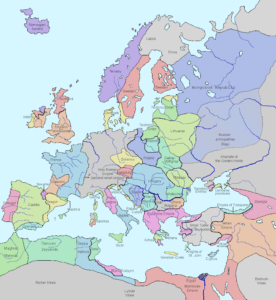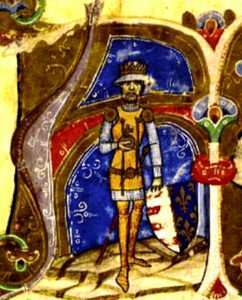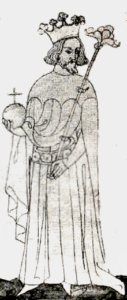19 November 1335 The Congress of Visegrád

On 19 November 1335, in the castle of Visegrád, the name day of the wife of King Károly Róbert I of Hungary, Erzsébet Piast, was celebrated, and the representatives of the Bohemian King John of Luxembourg, King Casimir III (the Great) of Poland and the Teutonic Knights, who were present, proclaimed the most important elements of their agreement and, not least, feasted lavishly. The Visegrád meeting of kings determined the balance of power in Central Europe for almost half a century.

This was the height of Károly Róbert’s diplomatic efforts. Having consolidated his power after constant power struggles, he was able to concentrate on his foreign policy, one of the pillars of which was undoubtedly the Polish alliance. Ulászló Łokietek I, like Károly Róbert, overcame the fragmentation of Poland and united the country, while he and Károly Róbert supported each other against their own rulers and sometimes against their neighbors.

The summit was also triggered by the sudden expansion of Habsburg power in the region, which had taken over Carinthia and Carniola after the death of Duke Henry of Gorizia-Tyrol, who had unsuccessfully claimed the Bohemian and Polish crowns.

However, previously, Károly Róbert also tried to reach an agreement with the Habsburgs, supporting them in their struggle against the German-Roman Emperor Louis of Bavaria, but this did not prevent the Austrian prince Frederick III (the Fair) from supporting the Kőszegi clan, which rebelled against the king, and from occupying Pozsony (Bratislava, Pressburg) and the Muraköz region. From then on he was interested in their isolation. The Poles were less troublesome and were happy to join a planned alliance.

The bigger challenge was to convince John of Luxembourg. The Bohemian king is best known to world history for later going blind and tying himself to his horse in the first great battle of the Hundred Years’ War at Crécy in 1346, and charging into the ranks of the English, who ignored him and slaughtered him along with thousands of French knights. At that time, however, he was just an ambitious monarch who had fallen out with all his neighbors.

With the Poles, because he had formed a claim to the Polish throne, he went to war with them several times, once being persuaded to turn back from Poland by the march of Kéroly Róbert’s armies to the Bohemian border. Károly Róbert was sometimes his opponent and sometimes his ally; before Erzsébet Piast, he was married to Beatrix of Luxembourg, the sister of the Czech king, who died prematurely.

But John of Luxembourg had also stirred up trouble with the Habsburgs and the Holy Roman Emperor. But his fighting had exhausted him, and when Ullászló was succeeded on the Polish throne by his son Casimir, the obstacle to a Czech-Polish settlement was removed.

The agreement was negotiated through Károly Róbert: John of Luxembourg renounced his title as King of Poland, and in return, Casimir paid him a substantial sum. Charles had agreed that if Casimir did not pay his debt, he would return either the Bohemian king’s letter of abdication or the remaining amount. The full amount was 1,200,000 Prague groschens. It was how Bohemian sovereignty over the Duchy of Silesia was recognized.

The actual celebration of the treaty of the alliance took place on November 19, the day of Erzsébet Piast, wife of the host king.

The Duchy of Silesia thus became part of the Czech Crown until 1742, when most of it was lost to Prussia and returned to Poland after the Second World War in 1945. A small part is now in the Czech Republic.
It was the first Congress of Visegrád where the rulers formed an anti-Habsburg alliance. They agreed to create new trade routes to bypass the main port of Vienna, which led merchants to offer their goods there before trying elsewhere and to gain easier access to other European markets.

The dispute between the Teutonic Order and the Kingdom of Poland was settled in Visegrád. The Poles asked Károly Róbert, while the German Knights asked John of Luxembourg to judge the case. The decision was presented to the Polish king and the Grand Master’s envoys in Visegrád on 19 November. As a result, Pomerania was given to the Teutonic Knights and Kujawy and Dobrzyn to the Kingdom of Poland. Although the war between the two parties did not end, the judgment was used as a reference for subsequent peace treaties and agreements.

The Hungarians, the Poles, and the Czechs mutually achieved what they wanted. It was agreed that trade routes from Hungary would be diverted from Vienna to Brno, with various concessions, and the following year the Bohemian and Hungarian armies invaded Austria together. Both the Bohemians, the Hungarians, and the Poles could now be sure that they would not be attacked by each other, and could concentrate on other areas of their foreign policy.

Source: Kanyó Ferenc and Wikipedia, and https://www.visegradgroup.eu/visegrad-1335/22-november-1335
Dear Readers, I can make this content available only through small donations. If you like my writings, please feel free to support me with a coffee here:
You can check out my books on Amazon, they are available in hardcover, paperback, or ebook:
https://www.amazon.com/dp/198020490X


My work can also be followed and supported on Patreon: Become a Patron!

https://hungarianottomanwars.myspreadshop.com/

